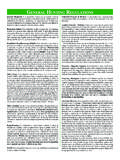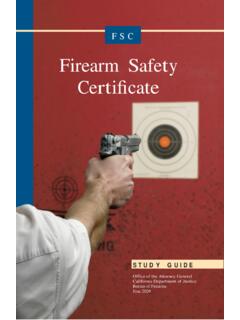Transcription of Leadership Essentials for Pharmacists
1 Learning ObjectivesAfter completing the chapter, the reader will be able to: 1. Define Leadership and explain possible paths to a Leadership role. 2. Explain the difference between formal and informal Leadership . 3. Discuss the origins of authority and sources of power. 4. List ways leaders use power effectively. 5. Cite common traits of an effective leader. 6. Differentiate between Leadership and management. 7. Describe Collins s hierarchy of Leadership . 8. Define various styles of Leadership . 9. Suggest Leadership development strategies. 10. Discuss the importance of exit Essentials for PharmacistsScott M. Mark, PharmD, MS, MEd, MBA, FASHP, FACHE, FABCR afael Saenz, PharmD, MSJohn S. Clark, PharmD, MS, BCPSJ ames G. Stevenson, PharmD, FASHP 239/13/12 11:49 AMIntroduction unless pharmacy students have considered the possibility of being called on to lead, they may not seek to develop the necessary skills to be successful in a Leadership role.
2 However, learning about Leadership is important, as highly trained Pharmacists are targets for Leadership roles in which they will provide guidance on professional and patient care decisions. If you are a pharmacist who is good at what you do, you will likely be asked to assume Leadership respon-sibilities; therefore, a better understanding of Leadership is ,2 1 In the pharmacy profession, transition into a Leadership role often happens serendipitously, resulting in what is sometimes called accidental Leadership . 2 Leadership is the process of influence in which one person is able to enlist the aid and support of others in accomplishing a common task, and the effectiveness of leaders is determined by both their level of influence and the outcomes of their decisions. 3 Formal leaders have formal power the right (authority) to hire and fire, transfer, demote or promote, and reward.
3 Formal power is bestowed through organizational authority, the result of holding a position within the organization (such as chief executive officer) or an assigned role affecting key outcomes (such as a designated project team leader). Informal power, however, is earned through relationships and experience. 4 There is a difference between holding a Leadership position and being a leader. Likewise, there is a difference between having power or authority that is earned and having power or authority that is bestowed. 5 Despite your title, role, or position on an organizational chart, you have the power to be a leader. Leadership is something acknowledged by others as a result of demonstrated vision, self-motivation, performance, determination, communication skills, credibility, ethical behavior, and ability to mobilize, motivate, Advancement to a Leadership position could be part of a formal organizational succession plan or the next step in an individual pharmacist s career 1In the phar-macy profession, transition into a Leadership role often hap-pens serendipitously, resulting in what is sometimes called accidental Leadership .
4 3 Situations that may result in Leadership opportunities can range from an unexpected vacancy on an executive team to recognition for a novel idea. Additional opportunities are presented in Table ,5 Several Leadership topics are addressed in this chapter, Key ConceptsThese key concepts are designed to focus learning, and the textual material that develops these concepts is easily identified throughout the chapter with circle-shaped icons indicating the key concept number (the end of each key concept is also denoted with a circle-shaped icon).and achieve desired results through others. A high-level position or formal Leadership role is not required for you to be perceived as a leader. 6 Pharmacist leaders must fuse the traits of Leadership with the professionalism expected within the pharmacy profession.
5 Professionalism is defined as the standards, behaviors, and character of an individual who is engaged in tasks related to his or her work or profession. 7 Although management is similar to Leadership in many ways, given that management and Leadership skills often overlap, management generally focuses on more operational aspects of an organization to achieve goals. Leadership is about doing the right things, whereas management involves doing things right. 8 Leadership theorists have characterized a variety of Leadership styles, and each style has both advantages and disadvantages. 9 Although several Leadership styles may work, leaders will be most effective when they select a style consistent with their personality, their brand, the environment in which they exist, and the people with whom they interact.
6 Optimally, leaders will be able to find environments in which they are able to demonstrate their preferred approach to leading others. 10 Growing your Leadership capacity requires sustained and deliberate Chapter 2 Leadership Essentials for 249/13/12 11:49 AMincluding the definition of Leadership , what it means to be a leader, Leadership characteristics, the differences between Leadership and management, styles of Leadership , strategies for developing Leadership competencies, and strategies for exiting Leadership positions. This chapter and Chapter 1, Management Essentials for Pharmacists , serve as the intro-duction for this text, as concepts presented in these chapters will be built on in later DefinedTrue Leadership is the ability to mobilize and inspire oth-ers; it is not solely about a title or a position.
7 As leader-ship authority John C. Maxwell noted, The true measure of Leadership is influence nothing more, nothing less. 6(p11) 2 Leadership is the process of influence in which one person is able to enlist the aid and support of others in accomplishing a common task, and the effectiveness of leaders is determined by both their level of influence and the outcomes of their ,8 In Leading Minds: An Anatomy of Leadership , psychologist and scholar Howard Gardner states, A leader is an individual .. who signifi-cantly affects the thoughts, feelings, and/or behaviors of a significant number of individuals. 9(pix) This is perhaps the most appealing aspect of Leadership the ability to inspire and influence others in profound and compelling can be found both formally and informally and at any organizational 3 Formal leaders have for-mal power the right (authority) to hire and fire, transfer, demote or promote, and reward.
8 Formal power is bestowed through organizational authority, the result of holding a position within the organization (such as chief executive officer) or an assigned role affecting key outcomes (such as a designated project team leader). Informal power, however, is earned through relationships and experience. Informal leaders, like so many social, political, cultural, and scientific trailblazers who have transformed their nations, commu-nities, industries, and professions, rely on the creation and articulation of a compelling vision of the future to achieve success but do so without the power and authority granted to formal leaders. They often have personal magnetism or charisma, expertise in their fields, a recognized history with the organization, or the ability to inspire others.
9 In many cases, informal leaders exert more influence on their fellow employees than do formal pertaining to informal power and allegiance are part of a formal leader s responsibility. Savvy formal leaders determine which individuals possess informal power and assess how they choose to use it. They then use this infor-mation to mobilize their support or work to ensure they do not create unnecessary obstacles. Seasoned formal leaders appreciate the value of recognizing, engaging, and involv-ing informal leaders in decision making and other key organizational ,13In the event you are called on to serve as a leader, whether formally or informally, you will face a choice: you can accept the role and hope to rely on the power of your title and responsibilities to accomplish organizational goals, or you can cultivate Leadership competencies and compel people to action by the way you think, behave, and interact with others.
10 Given the increasingly dynamic nature of orga-nizations, it is possible to hold a position today and lose it tomorrow. Building competencies to be both an infor-mal and a formal leader will provide you with an expanded array of opportunities. This holds true in student organiza-tions as well as work positions. Developing a wide scope of experiences provides a toolbox of Leadership skills from which to draw on in the future. Because skills such as lead-ing a meeting, interpersonal communication, and financial Table 2-1 Examples of Opportunities Resulting in Leadership PositionsPharmacist who is always asked to take a Leadership role on committees and/or other special projectsLead pharmacist who is asked to assume some Leadership responsibilities after his or her manager or director leaves the organization suddenlyPharmacist who is groomed and prepared by the owner of a retail pharmacy to understand aspects of patient care and the business of pharmacy in light of the owner s future retirementPharmacist who is seen as an advocate for patient care and is subsequently asked to lead a new clinical expansionPharmacist who develops a new teaching style or methodPharmacist who shares an innovative idea with a colleague and then is asked to present this idea to othersPharmacist who is known for










![Epictetus (55-135 C.E.), The Enchiridion [Manual]](/cache/preview/1/5/c/7/f/3/2/6/thumb-15c7f32666c5f32d8b67867743634dc3.jpg)





